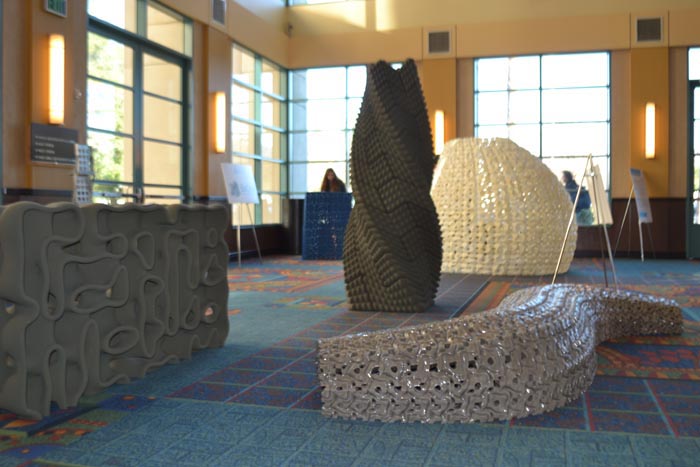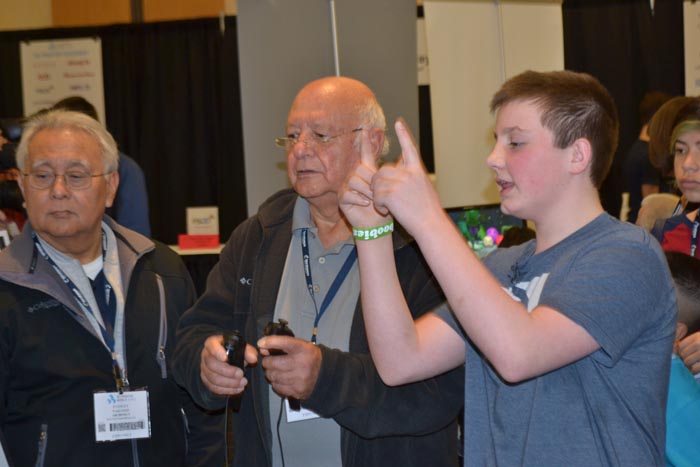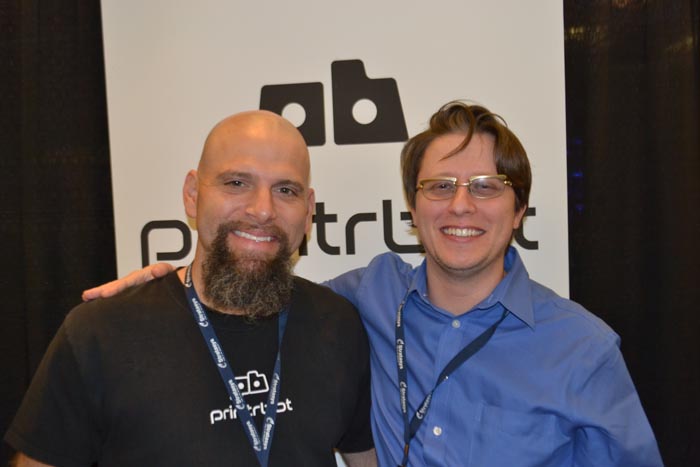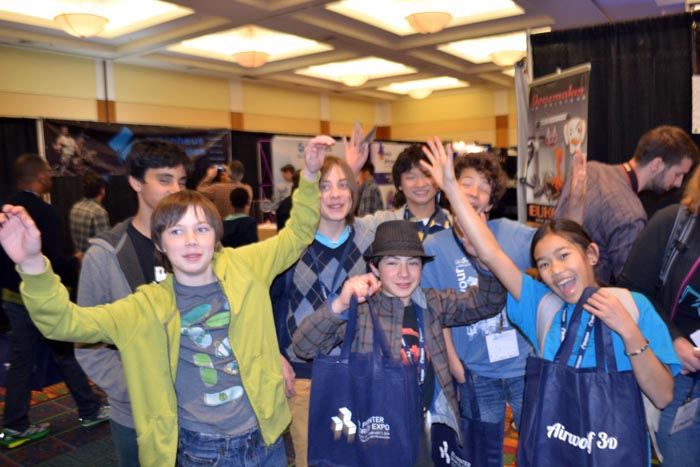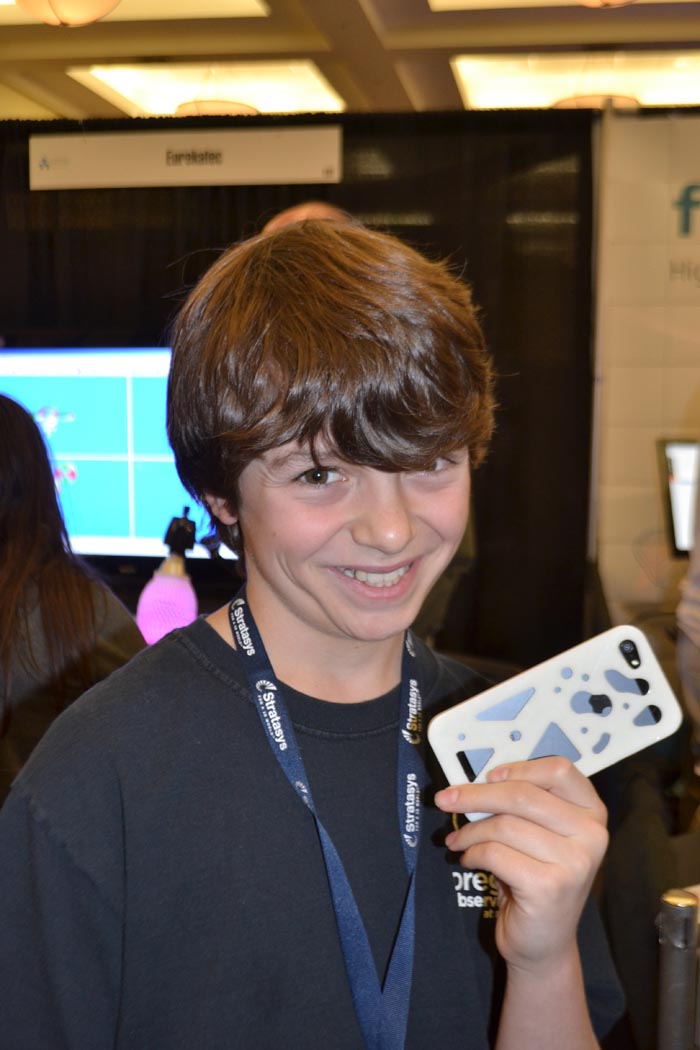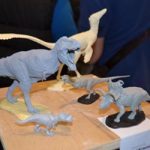The thing about all of these 3D printing expos is that there’s so much there! You become flooded with so much stimuli and information that, by the time you get home, your head is throbbing with data. In that way, the 3D Printer World Expo in Burbank this last weekend was no different. For me, there was one distinct difference about this event, though. There was sort of a feeling of accessibility there, from the contests and pavilions to the attendees themselves.
The event brought together a lot of Los Angeles’s local 3D printer companies, many of which I didn’t even know existed, as well as a few that had to travel from other parts in the U.S. to make it. Though some of the big players, like 3D Systems, Mcor, and Envisiontec weren’t in attendance, Makerbot and Afinia had booths set up and there were Stratasys resellers sprinkled throughout. This meant that we weren’t treated to the 3D-printed bands of 3DS, but were instead exposed to manufacturers like 3DMonstr, Invent-A-Part, and FSL3D.
When Scott (one of 3DPI’s new writers), Danielle and I arrived, we were greeted by the large 3D printed structures of Emerging Objects, interlocking pieces made of sand or salt to form uniquely contemporary art objects. I actually got to feel (but not taste) what a salt igloo feels like. On the opposite side of the hallway, a series of 3D printed movie props were set up, allowing patrons to see 3D printing’s impact in Hollywood blockbusters. And this was all before registration.
We sat through lectures covering 3D printing used in the medical field. Not the bioprinting stuff, though Organovo hosted a section of the Medical 3D Printing Pavilion. These talks were on the more immediate applications of 3D printing: 3D models for surgery prep, surgical guides and prosthetics. The topic of 3D models for surgical prep may seem a bit blasé when put up against organ 3D bioprinting, but hearing Dr. Neil Cambronero of the University of California at San Francisco describe the need for proper medical models to prepare for open heart surgery on newborns changes that quickly.
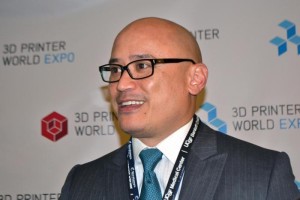
Did you know just how little cardiac surgeons know about the chest cavity they’re going into? As far as 3D models go, surgeons have those corny plastic hearts you’ve seen at the doctor’s office, but those are generalized to demonstrate the “normal” human heart; not tailored to a given patient. For specific patients, they have CT scans and ultrasounds that provide a sort of vague picture of the heart on which they’ll operate, but the picture is sketchy at best. They know the approximate problem and the approximate solution for an infant undergoing an operation, for example, but don’t have any proper visualizations of the specifics, how much material they’ll need to graft or the exact size of an artery. With the help of two grants from the Western Thoracic Surgical Association, Dr. Cambronero is working on developing detailed 3D computer models of individual patients’ hearts to properly prepare surgeons for the work they’re about to perform. These models can then be 3D printed for hands-on exploration of the surgical area.
After the lectures, we went straight to the Sixense booth to see the Make VR virtual CAD system in person. I had missed my meeting with them at CES, so this was my chance to see how a gesture-based, 3D modelling tool might work. After a thorough introduction to the software by Sixense’s Steve Hansted, I got to try the software myself. With these two handheld remotes wirelessly tracked by a nearby sensor, you can sort of drag yourself along this virtual world littered with blocks and pre-fabbed elements. Pick up a shape and stretch it or shrink it by moving your arms further apart or closer together, like pinching your fingers on an iPhone. And Steve was right, this is the sort of thing that kids have no problem picking up. It’s so much more intuitive than the series of elaborate dropdown menus you’d find in other CAD programs. The kid next to us had already personalized a line of mech robots lying around the scene in the brief time we were standing there. The software is designed specifically for 3D printing, so every object created within Make VR is watertight; you never have to leave the Make VR to print..
The Fuel 3D handheld scanner was as exciting as I’d hoped. The design of the scanner had changed, but the quality had not. In a second, they had snapped six photos of my face simultaneously and captured a photorealistic 3D model, an intensely accurate 3D camera. I’d been told that, in order to scan more data — to, say, scan my whole body — I’d have to take multiple pictures and stitch them together. To me, this wasn’t quite as helpful as something like the Structure Sensor/iSense, which allows users to 3D model entire rooms with a passing scan using an iPad. At the same time, it seemed more powerful than a tabletop scanner, such as the Digitizer, because of the high resolution of the scans. Watch me get scanned below!
More exciting than some of the tech was the fact that I got to meet two big figures in the world of desktop 3D printing: Johan Rocholl and Brook Drumm. Johan is renown for developing the basic design for deltabot 3D printers with his Rostock. Brook is the man behind the accessible Printrbot line, the most affordable machines on the market. Meeting those two, it was clear that their personalities had been expressed in the machines they’d built. Johan enjoyed his work with Google Analytics equally with his printer development at Open Beam in Seattle, but for different reasons. In particular, he pursued 3D printing for the sheer pleasure of designing and messing around — the sort of mindset that naturally leads to building something like the Rostock, innovating for innovation’s sake. Brook maintained an extremely laid back, open and honest attitude — telling us his feelings about the high pressure placed upon these small 3D printer manufacturers making their way in an exploding market. Despite these pressures, his machines remain open source and he owns 100% of the company, a paragon of the Maker community. Both Open Beam and Printrbot admitted that they’ll have some pretty big news in the near future (I even got a glimpse at one!) but was asked to keep them off the record, for now at least.
It was good to catch up with old friends, like Diego Porqueras from Bukobot. I haven’t seen Diego since I picked up my Bukobot from his store in Pasadena. Since I got it, they’ve released a couple of upgrades that I’m dying to apply to my machine, to give it a bit of improvement. No big news on this front, but they continue plugging away on the Bukito portable 3D printer, fulfilling their Kickstarter orders. Kids seemed to love the Bukobot booth, though. I couldn’t tell if it was that they loved to see the Bukito flipped by its handle to print upside down or the bright blue TARDIS they had on display, but they were definitely excited to be there.
Then again, the kids seemed excited by just about everything. Speaking with a handful of teenagers, each somewhere around 13-years-old, there was a palpable enthusiasm surrounding the technology. Christine Mytko, of Black Pine Circle middle school in Berkeley, had brought her student Makers club down to the show. The 3D Printer World people were kind enough to set aside a scholarship for young people wishing to attend, and Christing was able to get her students to the expo for free. They gushed over all of the printed objects, took a picture with Brook Drumm, and were happy to tell us which desktop printer brand was their favorite (it begins with “Maker” and ends with “bot”!). We asked them why they loved 3D printing so much and Abe, one 13-year-old, told us, “You can make anything you want just from some plastic!”
We met another adolescent who, at just thirteen, was giving FormLabs tips on the best 3D modelling software. Aidan had printed an iPhone case on his Airwolf 3D printer and was proudly showing it off to everyone he talked to. With a vocabulary like that of James Joyce and a thirst for engineering and neuroscience, Aidan was evidence of how much our youth are capable of. He’s already talking about starting a business printing things for his friends. Meanwhile, we overheard a man telling Brook Drumm how his son, after obtaining a Printrbot Simple, became so enthralled by the technology that he is in talks with a chemical company to go into business developing plastic feedstock. “How old is your son?” Brook asked. The answer? You guessed it! Thirteen years old.
The world really is changing quickly, as a result of 3D printing, Arduinos and the Making that accompanies them. I’ve never seen kids so excited about anything in my life. In turn, Danielle, Scott, and I all became as excited as they were. We ran from booth to booth, joyfully extending business cards, picking up printed models, saying happy things to everyone. It seemed as though the youthfulness had rubbed off on us. My cynicism had started to recede so that, as we drove our tired bodies home from the event, it seemed that I felt happy.
Photos by Danielle Matich


